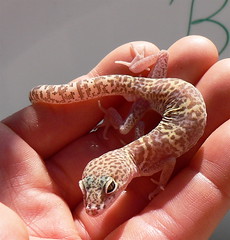Blue Scorpion
 Here's another photo from the herpetology field trip. There is something in scorpion exoskeletons that shines brightly under a black light. We went out at night to look for them armed with black light flashlights. When you come upon a scorpion (evidently any species) they really do glow in the dark. Switch to a regular flashlight, and you can barely see them at all since they're the same color as the sand underneath. I believe this one is a desert hairy scorpion Hadrurus sp.
We heard several theories that night on how this kind of ultraviolet decoration might have evolved. The best theory in my opinion is that the insects which are the scorpion's prey are attracted to ultraviolet light, thus making UV-reflecting scorpions better hunters. Plants sometimes use ultraviolet coloration on flowers to attract insects as well. I'm not sure how much research has been done on the adaptive function, if any. In a 1968 paper noted scorpion researcher SC Williams (perhaps less famous for being my biometry professor) describes how to use ultraviolet light to detect scorpions. So perhaps we've only known about this special feature of scorpions since then.
Here's another photo from the herpetology field trip. There is something in scorpion exoskeletons that shines brightly under a black light. We went out at night to look for them armed with black light flashlights. When you come upon a scorpion (evidently any species) they really do glow in the dark. Switch to a regular flashlight, and you can barely see them at all since they're the same color as the sand underneath. I believe this one is a desert hairy scorpion Hadrurus sp.
We heard several theories that night on how this kind of ultraviolet decoration might have evolved. The best theory in my opinion is that the insects which are the scorpion's prey are attracted to ultraviolet light, thus making UV-reflecting scorpions better hunters. Plants sometimes use ultraviolet coloration on flowers to attract insects as well. I'm not sure how much research has been done on the adaptive function, if any. In a 1968 paper noted scorpion researcher SC Williams (perhaps less famous for being my biometry professor) describes how to use ultraviolet light to detect scorpions. So perhaps we've only known about this special feature of scorpions since then.As with bats, who operate outside our hearing range, our imagination and thus our understanding is often constrained by the limits of our senses. Until someone thought to shine a black light on a scorpion, we would have had no idea to even consider this aspect of their evolution and its potential effect on the evolution of scorpion predators and prey.



